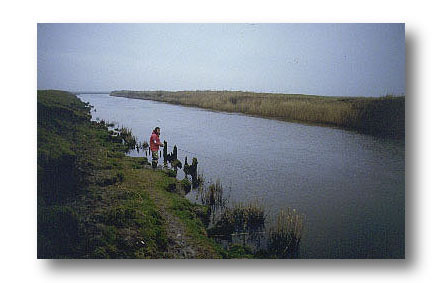|
But the river may look very different in
this early part of the season. It may be high and brown and look
extremely unattractive for both fish and fishermen if there is
a sudden thaw.

-
- Opening Day can be cold
and wet with high and murky water.
- © photo: Steen
Ulnits
The river may also be low and clear if
the winter has been dry, or if the snow is still held back by
Jack Frost. Such a situation is a dream come true, not least
for the fly-fisher, who has a little more difficulty in getting
his bait down than do anglers using spinners or worms.
Finally the river may be cold or freezing
cold. If it is only cold, it is possible to go angling - and
you might even catch something. If the river is freezing cold,
the odds are somewhat poorer, and they become truly miserable
if the temperature suddenly takes a dive - typically because
of a sudden thaw.
Most anglers are primarily interested in
the immature, silvery and fat-bellied "Greenlanders".
Fish that fight well and taste even better. The only problem
is that most of them are just below the minimum size limit, and
therefore have to be put back.
Unfortunately, a lot of the fish that are
under the limit swallow the hook if live bait is used. As a consequence,
they cannot be put back in a viable condition, and are lost.
This is a good reason for leaving the worms at home this early
in the season and instead trying a spinner or fly, both of which
are kinder to the fish.
Cod of the sea
At sea, the picture is reversed. Here the
anglers are primarily interested in mature cod, which are just
in the process of spawning at this time of year.
Because the cod is a typical winter spawner.
In the cold of winter they assemble in large shoals, and the
actual spawning is a kind of mass wedding where many fish spawn
at the same time. However, it is not a case of shoal spawning,
as the cod actually form couples.
The spawning takes place at places and
depths where the salt content is suitable because the spawn must
be able to flow freely in the water so it can be moved by the
current. If salinity is too low, the spawn will sink and maybe
die from lack of oxygen at the bottom of the sea.
The larger cod typically spawn in January-February,
whereas isolated cod populations in secluded areas may spawn
much later - in the spring months.
Cod of the lake
Burbot spawning also takes place in our
freshwater lakes at this time of year. The burbot holds a special
place among the fish of the lake - as our only freshwater codfish.
Its barbel reveals its kinship with the other varieties of cod
that all require salt water.
Like the other varieties of cod, the burbot
also likes cold water. This is demonstrated by the fact that
it chooses to spawn in the deepest part of winter, when the water
temperature is at its lowest. Very often the spawning takes place
below the ice, where the burbot gather in large shoals in deep
waters.
The burbot is a typically nocturnal fish
that during daylight hours hides in the dark . So fishing for
burbot in clear sunshine is doomed - you have to fish at night
- and use live bait - even in the winter
© Steen Ulnits
|

